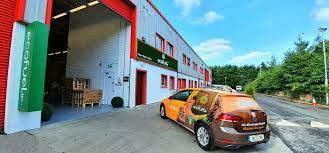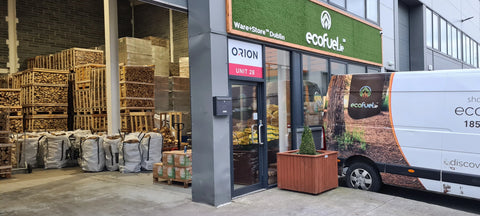Combining forestry with crop cultivation and livestock is a land management system that has been implemented across the world for the past 50-60 years, it was also adapted and relied upon heavily in early Roman times. Why then is it only now becoming such a topic of interest amongst farmers and landowners alike, and what exactly is Agroforestry?

Simply put, agroforestry is a land management system that incorporates planting trees on land usually used for crop growing or livestock grazing. The combination of forestry and crop or livestock farming allows landowners to diversify their stock and expand their economic stability. Another prevalent reason for it’s revived interest is as a method of tackling climate change and sequestering carbon emissions and greenhouse gases.
Why do it?
It’s a widely known and universally accepted fact that trees absorb carbon dioxide. It is also a widely known, but unfortunately less universally accepted, fact that earth is undergoing a climate crisis as a result of increased carbon emissions (amongst other reasons). It’s therefore a reasonable deduction that planting more trees would absorb more carbon and help in the fight against global warming. This is the simple version, if you’re into the science behind it we highly recommend this article from www.nature.com which does a lovely job of explaining it all!
 Image Source: www.carbonrally.com
Image Source: www.carbonrally.com
Other reasons for the increased uptake in agroforestry is the benefit the simple measure of planting trees can have on other crops in the field. The added nutrients to the soil and improved systems for water dispersal through trees complex root systems means that planting trees amongst your crops can increase the yield you produce in addition to growing timber that can be felled and sold also.
In France, the concept of agroforestry is nothing new. In the 19th Century it was common practice to have apple trees growing amongst the pastureland. But with research and developments in agroscience the practice is once again becoming much more commonplace. Researchers from National Institute for Agronomic Research (INRA) in Montpellier have unearthed the secrets to the success of agroforestry in the French countryside. Planting trees in crop fields leads to increased carbon in the soil which acts as a fertilizer to the crops and improves growth. Not only this but the shade provided by the trees reduces sun exposure and evaporation therefore further protecting the crops. Agroforestry will play a key role in the French ‘4 per 1000’ initiative which aims to increase carbon storage in agricultural soils by 0.4% each year in order to help mitigate carbon emissions.
Production Efficiency
As mentioned above, the combination of forestry in agriculture has shown a proven increase in the yield of crop planted. In studies carried out by the INRA one hectare planted with a walnut/wheat mix resulted in a 40% increase on crop yield than other land management systems. Similarly, a study from the US Forest Service showed that the incorporation of trees as a windbreaker resulted in a 56% increase in crop yields in mushroom growth and the presence of the trees protected from soil erosion, provided shade, and added moisture to the air.
Agroforestry in Ireland
In an effort to achieve our environmental targets, Ireland has committed to increase their forest cover from 11% to 18% by 2046. In order to achieve this, the Department of Agriculture, Food, and the Marine (DAFM) has established 4 schemes to encourage increased forest cover in Ireland. Amongst Afforestation, Establishment of Native Woodlands, and Forestry for Fibre, there is the Agroforestry Scheme. The grants aim to encourage the uptake of agroforestry by assisting with the set up costs of a new plantation.
The benefits of an agroforestry scheme in Ireland would be huge. As was established in France, the introduction of agroforestry increases the nutrient value in soil therefore producing better crop growth. Other benefits include an increased biodiversity in land use for the owners, leading to a more economically diverse strategy for farmers who can expand their crop for sale but also use the land to graze animals.
Agroforestry Grants in Ireland
Common Agricultural Policy (CAP)
The Common Agricultural Policy (CAP) is a European Union initiative that ensures farm owners across the EU have a decent standard of living while maintaining their farm land. The Teagasc National Farm Survey in 2018 shows the average CAP payments for farmers in Ireland was €17,786. These payments are allocated only to farmers who actively farm their land and are based on the amount of eligible hectares they declare in their application, and the ‘payment entitlements’ they have applied for based on the activities they undertake on their land i.e. crop growth, livestock etc.
 Image Source: independent.ie
Image Source: independent.ie
In 2020 there was the addition of ‘Greening’ conditions in the CAP application process. This is designed to encourage farmers to employ environmentally conscious measures in their farming that supports reductions in carbon emissions and achieving climate goals. With these stipulations 30% of the direct payment for each farmer is based on achieving environmental targets. One of these measures includes “dedicating 5% of arable land to areas beneficial for biodiversity”, which would include forest cover achieved by agroforestry.
Department of Agriculture, Food, and the Marine
The biggest grant available to landowners hoping to embark into agroforestry comes in the form of the Department of Agriculture, Food, and the Marine (DAFM) Agroforestry grant. This grant is available predominantly to owners of silvopastoral farmland (simply put land that can be used for grazing, silage and hay) and in some individual cases with alternative farmland. The grant will assist in the development of your initial agroforestry plot helping with the costs of planting, foresters, and fencing.
Qualifying for the DAFM grant is generally straightforward, if the land you propose to plant has enough space for between “400-1000 trees per hectare, is at least 0.5 of a hectare and at least 20 meters wide” then it is likely you will fall under the grant guidelines. You’re probably thinking to yourself ‘400-1000 trees is an awful lot of trees!’, it is. But this will thin out in time and the aim is to have in the region of 160-250 trees per hectare which is much more manageable and will still allow light to permeate the canopy ensuring grass can still grow underneath to support other farm activities.
Farmers implementing agroforestry are advised to plant trees at a distance in which they can still cut silage in the field so as to not impede their usual farming activities. Similarly, if the land is used for pasturing or grazing it is required that protections are put in place for the trees to stop animals from damaging them while in early stages. Tree shelters must be fitted to saplings until they outgrow them, at which time protective mesh must be put in place to continue to protect the trees from grazing animals either rubbing up against them and causing damage or from animals nibbling on them.
 Image Source: (l) Kestralforestry.ie (r) Arbourvitaeuk.com
Image Source: (l) Kestralforestry.ie (r) Arbourvitaeuk.com
Should your future agroforestry venture be part of a larger plantation you are also required to erect suitable fencing to ensure that animals do not stray into your plot and cause damage. As we will look at below, there is additional funding available should you require this.
A core element of the agroforestry drive is to encourage the growth of more common and native trees in Ireland’s landscape. The DAFM grant encourages the planting of Oak, Sycamore, and Cherry trees, these can be intermixed with up to 15% of nut and berry trees giving an alternative crop for landowners to produce for commercial or personal use. Allowances can also be made for other species of broadleaf or conifer trees but this is on a site to site basis.

The table below outlines the grant available from DAFM. We will then go into a little more detail about each section. Please note that funding is based on a per hectare basis.
|
1st Grant |
2nd Grant |
Additional Fencing |
Alternative Fencing |
|
|
GPC 11 Agroforestry |
€4,215/ha |
€1,405/ha |
€600/ha |
€450/ha |
Your First Grant payment is in place to provide you with financial support for the logistics of setting up your agroforestry plot such as ground preparation, drainage, fencing, forester fees (if necessary) and will be paid out once it is shown you adhered to the conditions and guidelines in place.
The Second Grant payment will be paid after 4 years of successful growing when your trees are well established and maintained in accordance with the specifications of the grant. This section of the grant is to cover costs of replacing failed growths and maintenance of your trees.
Additional Fencing will be paid out with the First Payment and will cover the costs of any fencing materials you may need to take to protect your newly planted trees from animal or environmental impacts.
Alternative Fencing is not required for every agroforestry project but if you have a particularly large plot or plantation as mentioned above, suitable protection is required to avoid interference from animals outside of your own farm.
Maintenance/Inhibitors
Now let's look at the other side of the coin; we’ve looked at all the positive effects of introducing agroforestry into Irish farms, but what are the drawbacks?
The biggest obstacle to increased agroforestry adoption in Irish farms is the statutorily mandated replanting obligation as set out in the 2014 Forestry Act. When you decide to develop a tree plantation on your land you must register this land as forest area, once this is done you enter into a licencing agreement with the Minister of the Dept of Agriculture, Food and the Marine. Under this licencing agreement you are required to maintain the trees on your property to acceptable standards, replace them in the event of weather damage or illness in the trees, and to replant any trees felled. Applications must be submitted to the Minister for consideration before felling any trees on your property under the agroforestry scheme and the obligation to replant is standard in these considerations.
The replanting obligation on your property is such that if the land transfers ownership due to selling or inheritance the requirement to maintain the forest plantation remains in place. Meaning that should your land be passed down in generations, your family will be burdened with the cost of replanting the forest after felling but without the benefits of the grant you have received to begin the process and will not see the financial benefits of this for 20-30 years (tree species dependant) when the crop can be harvested again. Moreover, the value of land with a forest plantation in place will be significantly lower because of the difficulties in repurposing it than if the land was just used for crop growing or pasturing.
The 2014 Forestry Act provides the Minister with legal repercussions for those who do not comply with replanting obligations or who fell trees without receiving the necessary permissions in advance.
The Minister can impose the following sanctions for failure to comply with replanting orders in accordance with Section 26 (6):
(6) An owner who fails to comply with a replanting order shall be guilty of an offence and be liable-
(a) on summary conviction, to a class D fine, or
(b) on conviction on indictment, to a fine not exceeding €5,000, for every period of 30 days during which such failure continues.
Similarly, sanctions can be placed on those who would fell or allow the felling of trees on their property without the proper licencing and permissions from the Minister under Section 17(6) of the Act:
(6) A person who—
(a) fells or otherwise removes one or more trees, or
(b) causes or permits one or more trees to be felled or otherwise removed, without a licence, or in contravention of a condition of a licence, shall be guilty of an offence and be liable—
(i) on summary conviction, to a fine not exceeding €200 for every tree in respect of which the offence was committed (but which total penalty shall not exceed €5,000) or imprisonment for a term not exceeding 6 months or both,
or
(ii) on conviction on indictment, to a fine not exceeding €1,000,000 or imprisonment for a term not exceeding 5 years or both.
It has been argued that the government mandated replanting is more of a deterrent to the uptake on agroforestry and more relaxed stipulations would result in more interest in the scheme. While the government claims its legislation gives flexibility as all matters are at the discretion of the Minister it has also been very vocal in ensuring they get value for the investment they are making in agroforestry plantations. Indefinite replanting means once they increase the percentage of forest cover in Ireland through well funded startup schemes these figures will not reduce again after each growth season.
So there you go, this is everything we know that we thought you might like to know about Agroforestry! There are obvious benefits to the establishment of agroforestry plots not only for the government in achieving their environmental targets, but also for farmers and landowners to diversity their crop and profitability while having the added visual bonus of a beautiful plantation to tend to and admire.
What are your thoughts on the future implementation of forestry in Ireland's agricultural landscape?


 Image Source: www.carbonrally.com
Image Source: www.carbonrally.com Image Source: independent.ie
Image Source: independent.ie Image Source: (l) Kestralforestry.ie (r) Arbourvitaeuk.com
Image Source: (l) Kestralforestry.ie (r) Arbourvitaeuk.com

